<!—->
When we last wrote about Starship SN9 in the pre-Christmas article, this prototype was just transported to the ramp to undergo a series of pressure tests and static ignitions. Testing was expected to be shorter than the previous SN8 prototype, so some hoped the Starship SN9 would take off in early January.
However, testing did not go smoothly in the end. Due to engine problems, it was necessary to replace some Raptors and then repeat the static ignitions, so testing was completed only now. Today we will summarize how the SN9 was tested, when the prototype will take off and how preparations for other Starship and the Super Heavy launcher continue.
The flight of the previous prototype Spaceship (SN8) ended in flames, yet the company considered the test successful:
Another in a series
SN9 is another of series of development prototypes spaceship Starship. It is very similar to the SN8 specimen, which was tested from the beginning of October 2020 and performed two months later Starship’s first test flight in full size.
The prototype was destroyed during a test flight, but it was not a big problem, because SpaceX at that time already had almost finished SN9. It differs only slightly from its predecessor, but the novelty is that on the SN9 there is a small tank with methane reserved for landing pressurized with helium. Elon Musk explained that this was a temporary solution to the low pressure problem that caused the SN8 to fail to land.
Helium also pressurizes the tanks on the Falcons, but at Starship, all tanks are pressurized directly with methane or oxygen gas so that helium is not needed at all.
According to Musek, a long-term solution to this problem with the methane landing tank is currently being worked on, but it has not yet been decided which solution will be the simplest and will have the lowest weight. On the Starship SN9, the main tanks and the small oxygen tank at the tip are pressurized with methane gas or oxygen, but the small methane landing tank is the only one pressurized with helium.
Methane landing tank inside the main tank of the Starship SN4 prototype
—
Under the prototype Starship SN9, however, the pedestal collapsed on December 11 and the ship leaned against the wall of the assembly hall. However, the damage was only slight and after the replacement of two control surfaces was a prototype transported to the starting rampto undergo ground testing and preparation for his own test flight.
Unlike the SN8, the latest Starship was transported to the ramp almost complete – the ship had a tip installed, aerodynamic control surfaces and also two of the three Raptor engines. The Starship SN9 was transported to the ramp on December 22, 2020, and a day later the missing third Raptor with serial number SN49 was installed in it. The other two engines were identified later. By the way, the Raptor SN45 was also seen in Boca Chica, which had a mossy green nozzle for an unknown reason.
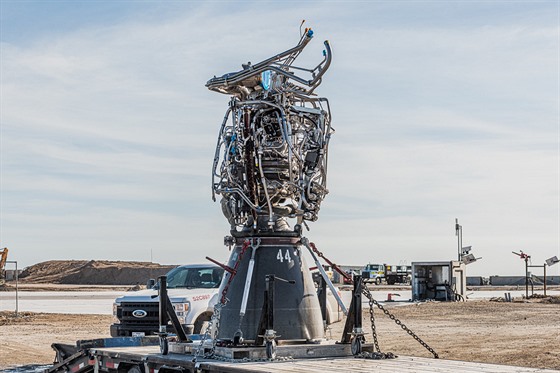
Damaged Raptor SN44 after removal from Starship SN9 in January 2021
—
The SN9 pressure test with nitrogen gas took place on December 28 and kryogenní test with liquid nitrogen was performed a day later. After the New Year, it took place on January 6, 2021 static ignition of all three engines at once. However, it was allegedly shorter than planned, so it needed to be repeated.
Exactly a week later, SpaceX surprised fans when three static ignitions were performed in a relatively fast sequence during January 13th. SpaceX has never performed more than one ignition in one day. From an operational point of view, it was a decent success, but later it was found that the ignitions themselves were not without complications. During the tests, the Raptors SN44 and SN46 were damaged, which then had to be dismantled and replaced with other pieces.
In connection with that Elon Musk explainedthat SpaceX is working on major modifications to the engine replacement process at Starship. The goal is said to be that the exchange takes a maximum of a few hours. The replacement of the two engines eventually took less than a week. On January 20, three attempts were made to perform a static ignition to check the newly installed Raptors.
But they were all interrupted for unknown reasons, sometimes just a few seconds before ignition. So the test in the end took place a day later, but it was extremely short, as it was probably prematurely terminated. The next day, a few seconds were finally performed final static ignitionwhich already looked good. The ground testing of the SN9 should be completed and the next in line is a test flight similar to the one that completed the SN8 prototype last December.
Elon Musk after the final static ignition saidthat SN9 flight “perhaps” will take place at the beginning of the last week of January. Air closures over Boca Chica, which are needed for Starship test flights, are currently announced on January 27-29. But delays are common, so follow ours continuously updated page, where you will always find the latest information from SN9’s preparations for the flight.
As I mentioned, the SN9 test flight should be very similar to the one that the SN8 prototype made in December, so you can remember it via official montage.
You can also watch the following unofficial animation. It nicely illustrates the assumed internal arrangement of the pipeline inside the Starship SN9 and also clearly shows the principle of operation of smaller landing tanks. One can only hope that SN9, unlike SN8, will be able to land successfully.
Other prototypes produced
The question is whether the Starship SN9 will perform more than one test flight, even if it manages to land. SpaceX is in production a variety of other Starship prototypes and the oldest of them are probably technologically obsolete.
So maybe it’s not very important for SpaceX to delay further testing of SN9, when it can go straight to newer prototypes of SN10 or SN11. The first one is basically finished – during December 2020, its aerodynamic tip was completed, which was then connected to the tanks on January 2, 2021. The tail control surfaces were installed in mid-January and then work took place inside the ship.
So now the SN10 prototype should be basically ready to move to the ramp and start its own testing. Completion of the next prototype Starship SN11 is also nearing completion. The tanks were completed at the end of December and now the aerodynamic tip, which already has control flaps installed, is being completed.
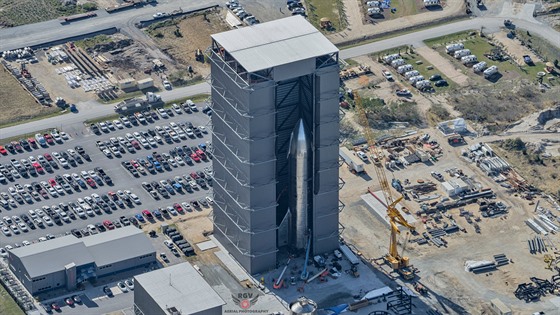
Aerial shot of the completed Starship SN10 in the assembly hall
—
At the same time, components for the SN12 to SN18 prototypes have already been seen in Boca Chica, but from local observations, it appears that SpaceX will completely skip the completion of the Starship SN12–14 prototypes and move straight to SN15.
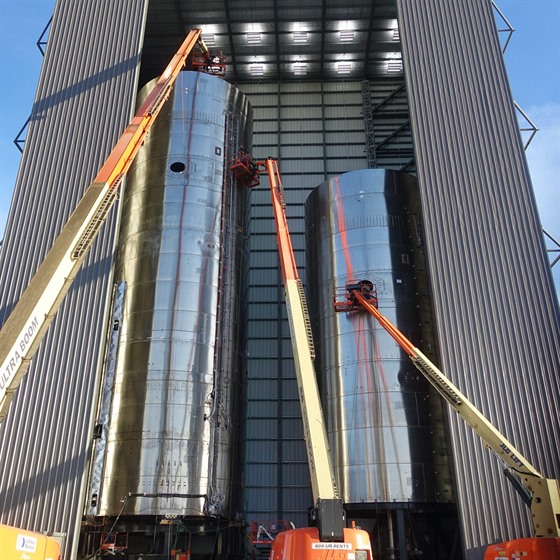
Starship SN10 (left) and SN11 prototypes in the assembly hall during production in December 2020
—
According to Elon Musek, this prototype should contain more significant changes compared to older versions, such as the SN9, and should be closer to the orbital variant of the Starship.
In addition to Starship, SpaceX also manufactures prototypes of the Super Heavy launch vehicle. The first BN1 specimen has been in production since last autumn, but its completion is probably awaiting the commissioning of the overhead crane in the High Bay hall. In the meantime, however, the first segment for the second prototype of the Super Heavy BN2 was also seen.
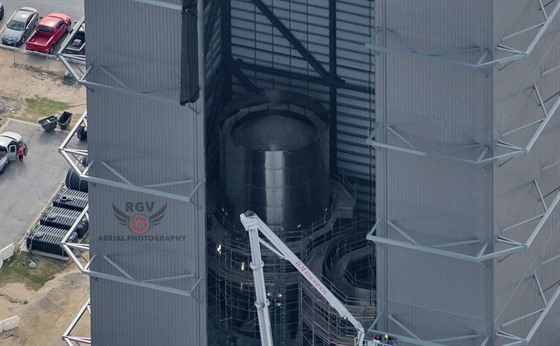
Super Heavy BN1 embryo in the assembly hall
—
And to make matters worse, SpaceX managed to produce a smaller SN7.2 test tank in parallel with all this. It is similar to its predecessor SN7.1, but differs in the use of thinner steel. Previous Starship tanks and prototypes used four millimeter thick stainless steel, while the SN7.2 steel is only three millimeters (it’s not clear if it’s 304L steel or some other type).
On January 20, 2021, the tank was transported to the starting ramp, where it will probably be pressurized with nitrogen until it was destroyed, similar to the previous test tanks SN7.1, SN7, SN2 and others. If the tank withstood the required pressure level, thinner steel would result in a reduction in the total weight of the Starship by a few tens of tons. And every tonne saved in Starship weight represents a ton more capacity in orbit.
However, the assembly site in Boca Chica is not inflatable, so SpaceX is gradually disposing of some old Starship prototypes, for which it is no longer used and is just taking up space.
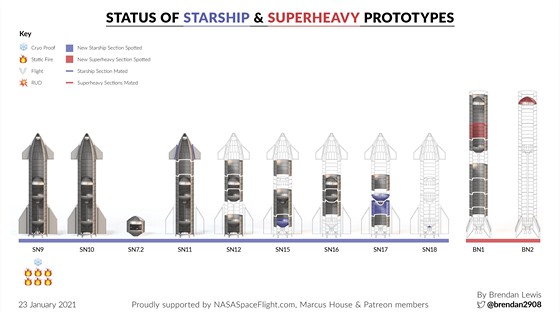
Status of individual Starship and Super Heavy prototypes as of January 23, 2021
—
In recent weeks traveled to the meal aerodynamic top of the very first prototype Starship Mk1 and also the prototype SN6, which last summer performed a short test flight to a height of 150 meters. When disposing were spotted also parts of the Starship SN12, which records the above-mentioned theory that the prototypes SN12 to SN14 will not be completed.
The article was created pro server ElonX.cz. The text was edited before publication, the original can be found here.
<!—->
– .


